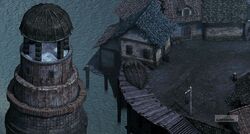RPG Codex Preview: Underrail
RPG Codex Preview: Underrail
Preview - posted by JarlFrank on Wed 29 August 2012, 13:11:04
Tags: Stygian Software; UnderrailUnderrail, the post-apocalyptic indie RPG which has a demo out and the developer posting regularly on the Codex, has been officially previewed by none other than me.
So, don't waste any time and go read that preview! (And play the demo if you haven't already.)
Read the full article: Underrail Preview
The indie RPG Underrail, which had its demo released recently, feels and looks very similar to one of the most popular Codexian classics - Fallout. When I played the demo, many of its aspects reminded me of Fallout. The flavour text when examining some objects, the character system, the combat, and even the atmosphere in some parts of the game. But is it actually good? To find out, read the following preview!
So, don't waste any time and go read that preview! (And play the demo if you haven't already.)
Read the full article: Underrail Preview
Underrail Preview
The indie RPG Underrail, which had an alpha demo released recently, feels and looks very similar to one of the most popular Codexian classics - Fallout. When I played the demo, many of its aspects reminded me of Fallout. The flavour text when examining some objects, the character system, the combat, and even the atmosphere in some parts of the game. But is it actually good? To find out, read the following preview!
The character system
Underrail's character system is just what a chacter system should be like: it is both complex and intuitive. There are 7 stats and 21 skills, many of which are forming synergies (for example Persuasion and Mercantile: 20% of each skill's value will be added to the other's in any skill check). On top of that, the game has many feats that give you special abilities or enhance your stats in certain situations. On each levelup, you get to assign skillpoints and pick a feat, while on every second levelup you also get one point to add to your stats.
The character system is, overall, very solid. I have tried many different characters, and all of them could get through the game without any major problems. Since the maximum value of your skills is tied to your level - every skill can only be raised to 15 at level 1, 20 at level 2, 25 at level 3 and so on - it is almost impossible to create a useless character, as the game forces you to pick multiple skills, and since you gain a substantial number of skillpoints on each levelup, some of those are bound to go into a useful combat or psi skill. On the other hand, it means that some skillchecks are completley impossible for characters of too low a level, since you cannot raise a skill beyond it's current limit.
Underrail offers the player combat skills, stealth skills, psi skills, social skills and crafting skills. While I haven't tried out the crafting skills, all the other skills are equally useful and get plenty of opportunities to be used. In the demo, there aren't many checks for persuasion or intimidation yet, but those that are there offer substantial rewards if passed. In one sidequest, where you can pick one of three items as your reward, you can use your mercantile skill to get all three of them. At one point of the main quest, you can gain access to a small dungeon with a successful persuasion check - a dungeon that would otherwise be closed to you.
Combat
There are four combat skills in total: guns, grenades, crossbows and melee. While grenades are mostly a support weapon useful against crowds, the other combat skills are roughly equal in their usefulness. Melee weapons are of great use especially in the beginning, since they have a low action point cost and (obviously) don't use up any ammunition, and later in the game you can get powerful sledgehammers which deal a lot of damage. There are many different types of guns, from handguns over SMGs to sniper rifles, each with its own area of use. Overall, guns seem to be the most versatile weapons due to the many different types you get to use. What I've found interesting about guns is the way you reload them: you can choose to reload an entire magazine, or just a single bullet which costs only a fraction of the action points a full reload would take. Crossbows are medium-damage weapons with long range and a good critical chance, and the potential to be used stealthily.
The combat mechanics themselves reminded me a lot of Fallout, if Fallout lacked aimed shots. It's based on action points, with the interesting twist that, in addition to your normal action points, you also get a couple of movement points that can only be used to move your character. This means that you can maneuver your character around without losing valuable action points that could be used for shooting. The system works really well, especially for melee characters who have to run up to ranged enemies before being able to hit them - the movement point system prevents you from wasting half of your action points before even reaching the enemy.
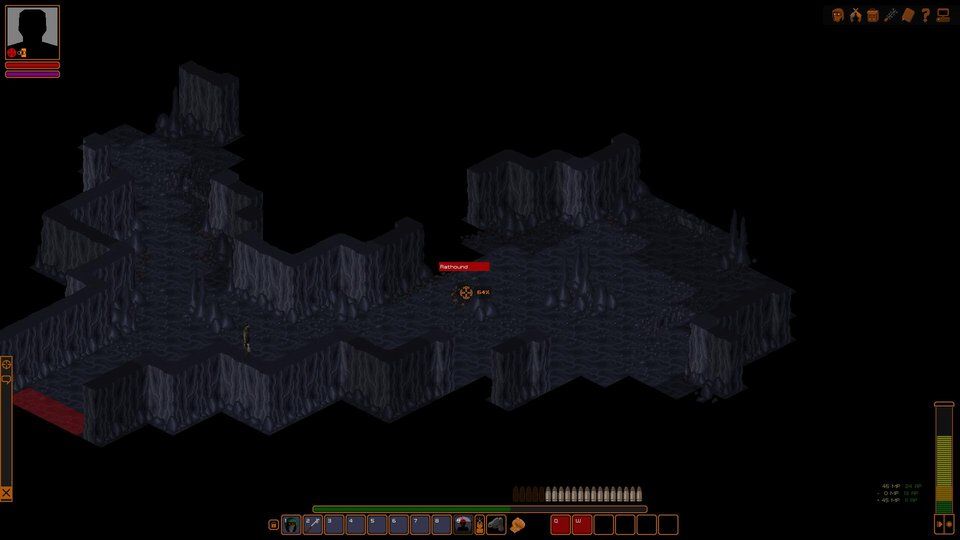
While Underrail lacks aimed shots, it has several special abilities to make combat more interesting. These special abilities are usually earned by picking feats - such as the feat Aimed Shot that gives you the ability to execute aimed shots that give you a guaranteed critical hit, or the Snipe feat that gives you the ability to inflict additional damage with rifles or crossbows while your character is in stealth mode. To prevent these abilities from being too overpowered, they all have a cooldown of several turns; I'm not too fond of the cooldown mechanic, but it works well enough. I found them to be a little excessive, though - even going into stealth mode has a cooldown for some reason.
Overall, the combat is solid and entertaining, but nothing special. If you liked Fallout's combat system, you will like Underrail's, if you didn't like Fallout's combat system, you also won't like Underrail's. Apart from the lack of aimed shots and the special abilities you can get, the combat feels so similar as to almost being identical.
Magic... er, Psi
Another major tool for your character - and a possibile direction of character development - are psi abilities. At the beginning of the game, you are diagnosed with certain elements in your genetic code that allow you to manipulate the world around you with your will - with psi abilities. Psi abilities are acquired in a different way to normal combat abilities. Instead of choosing a feat, you have to pay others to teach you the ability. Often, a character who can teach you a psi ability will either have a task for you before he even offers to teach you, or offers to teach you an ability for free if you help him out.
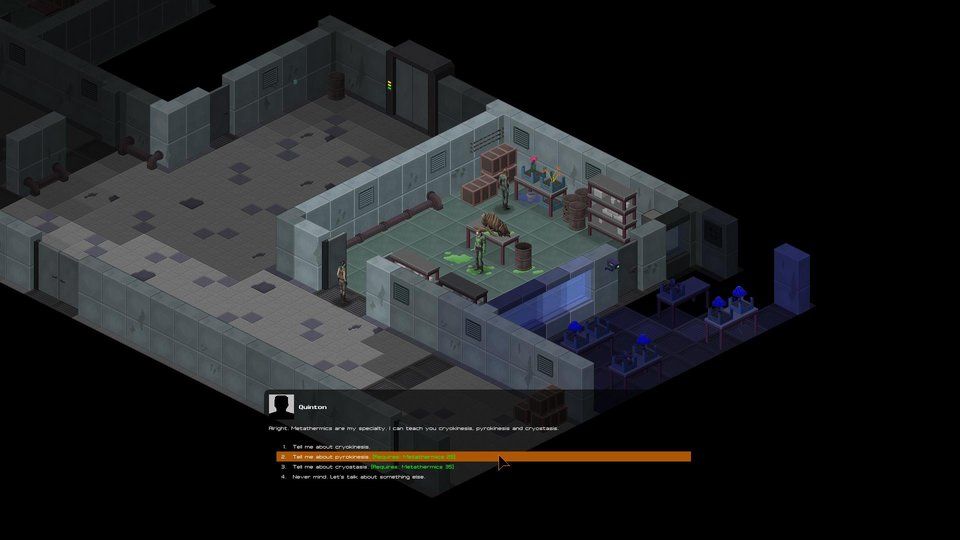
Most of the psi-abilities are really useful in combat. They range from powerful attacks against a single opponent over area-effect abilities to "debuffs", such as freezing an enemy and preventing him from movement. Overall, the psi abilities in this game felt very much like magic spells to me. Most of the psi abilities have a direct equivalent in the D&D spell list, such as Pyrokinesis, which is nothing more than a fancily-named fireball. In the game, this ability is described as: "Creates a ball of superheated gas and hurls it to the designated area. Everyone caught in the blast take X heat damage." Yup. It's just a fancily-named fireball. Using these abilities consumes a certain amount of psi (mana), which can be regenerated by using a psi booster (mana potion). It's pretty much a sci-fi version of high fantasy magic.
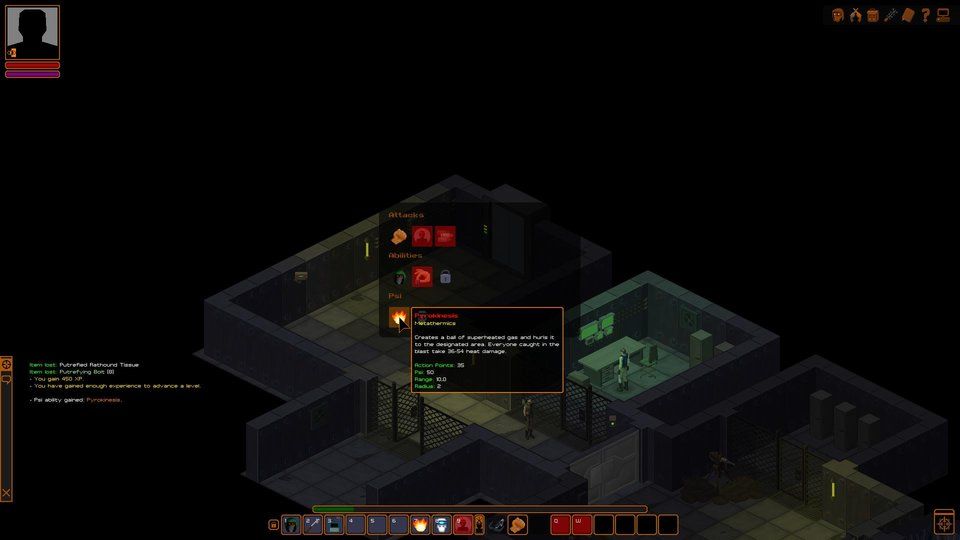
Now, playing a character who focuses on psi abilities is a lot of fun, and it's probably one of the most interesting elements of the game, but the implementation feels a little out of place. Psi abilities are explained in-setting, the concept makes sense enough, but most of the abilities just remind me too much of typical high fantasy magic spells and feel out of place in this generally more down-to-earth post-apoc setting.
Sneaksie Thiefsie
The stealth in Underrail has to be one of the best stealth systems I have ever seen in an isometric RPG. Once you go into stealth mode, your character model appears translucent and your movement speed is reduced. Enemy chance of detection is influenced by their line of sight and by the amount of light. If you sneak up on an enemy from behind while it's dark, your chances of not being detected are much higher than when you're in the light, or when the enemy is facing you. It's simple, but it works to great effect. There are many places where you can use light switches to darken a room to make it easier to sneak. When you approach a monster or a NPC, a green eye-symbol appears above their heads that slowly becomes yellow, and then goes from yellow to red - when it's yellow, the character is suspicious, and when it has become red, he has detected you and you enter combat mode.
Playing a stealthy character feels really rewarding and I had great fun playing a stealth specialist. Once your stealth skill reaches very high levels, though, it becomes a little overpowered - with a stealth skill of about 50, I managed to sneak into the doctor's office through the door the doctor was facing, with lights on, and managed to stay undetected and rob every closet in the office. Plundering containers doesn't raise your chance of detection, and won't lead to being detected while a character is alert, either, which means that you can sneak into the shop of a friendly merchant and rob everything as long as he hasn't detected you yet. You can sneak inside, rob everything you can until you're detected, leave the room, sneak in again and steal everything you didn't manage to get on your first run.
You also have the ability to pick locks or hack electronic locks. For that, you need a lockpick or a Haxxor-tool, respectively, and use it on a locked door or container. It's pretty straightforward. One nitpick I have, and something I hope is changed in the full version, is that many locked doors appear unpickable. You use your lockpick on them, watch the lockpicking animation - and get a message that it's impossible to pick this lock. This only happened with doors that lead to areas which are entirely inaccessible in the demo, so I assume that in the full game, all locks will be pickable.
Level Design
The level design in Underrail ranges from okay to excellent, and most of the quests are pretty interesting. The first task you get is to explore the caves, find a couple of abandoned outposts, repair a generator and switch electricity back on in these outposts. It's quite a bit more interesting than the usual fedex-quests we get in most RPGs. The encounters during this quest mostly consist of rathounds, though - mutant animals comparable to Fallout's molerats - which aren't very interesting as opponents. The game really picks up once you reach the first major dungeon, the GMS compound. You are given the task to find a way to open a large bunker door within the compound - and then you're free to explore this compound on your own and find a way to get that door open.
The GMS compound is an excellent dungeon. It consists of three levels, the first two reachable by elevator (once you have found the power control unit and activated it) or stairs and the third only reachable via an emergency trapdoor. On each level of the facility, there are ventilation shafts your character can enter and use to get from one end of the map to the other without being detected. When I first entered one of these ventilation shafts and started exploring them, I got a distinct Deus Ex vibe for some reason. The second level of the facility contains sentry robots that are quite hard to defeat and should be avoided - a great level to stealth through. There are also surveillance cameras that can detect you even when stealthed, so it was a very intense experience.
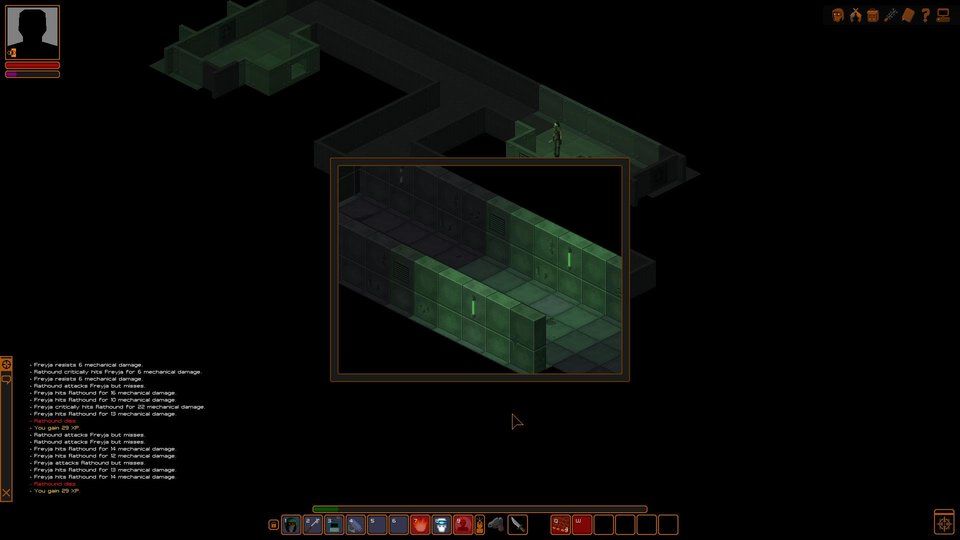
When you reach the third level, you meet two raiders holding some old man hostage. You can try to intimidate the raiders, or attack and kill them to get some hints from the old man on how to defeat the rest of the raiders who have invaded this place and killed or captured its inhabitants. You can try to take out the raiders and free the captives for some extra experience... or you can just avoid conflict, look for the key you need, grab it, and get out.
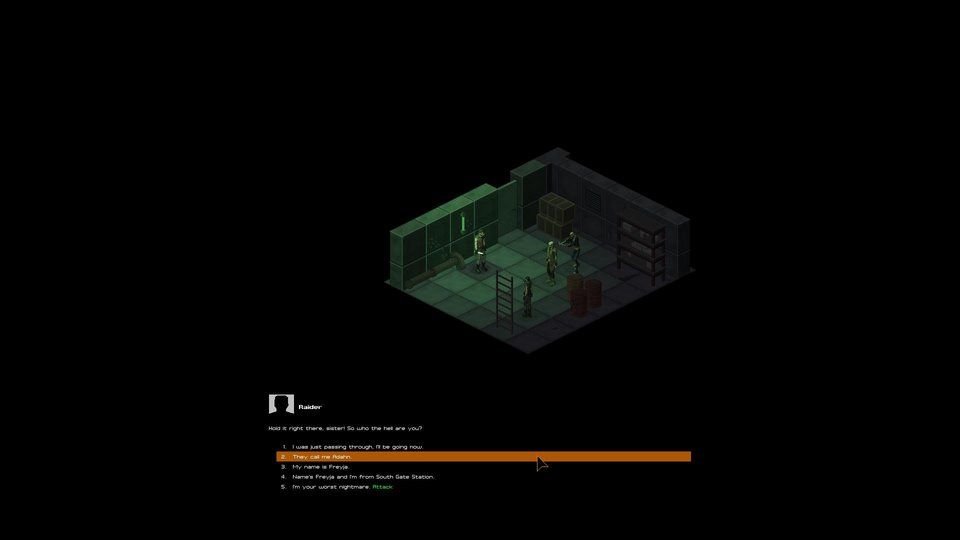
From what I have seen, it is very much possible to complete this game without a single kill. Stealth is useful and viable, and - at least in the demo - there is no quest that forces you to kill anyone. There is a sidequest where you have to kill a rathound with a special crossbow bolt, but since it's only an optional sidequest, you can totally avoid combat in Underrail if you choose so. By using stealth and social skills, every fight can be avoided.
Conclusion
If the rest of the game's content is of the same quality as what's provided in the demo, Underrail has the potential to become a classic on par with the old Codexian favourite Fallout. The character system is complex but intuitive, there's a large variety of different possible character builds - all of which are valid choices, no type of character sucks so hard he'd be inconvenient to play - the core gameplay elements are solid, and the level design is generally clever with some excellent high points.
There are only two little things I have to criticize: the walking speed could be a bit faster, and there are quite a few typos, especially in item and ability descriptions. Other than that, the game has no major flaws - the loading times are fast, there's a large amount of resolutions to choose from including widescreen resolutions, and I didn't have a single crash even when running the game for hours and alt-tabbing out of it multiple times. On the technical side, it seems to be very polished.
In conclusion, Underrail is a great game with solid mechanics and good level design that is definitely worth looking forward to.
The indie RPG Underrail, which had an alpha demo released recently, feels and looks very similar to one of the most popular Codexian classics - Fallout. When I played the demo, many of its aspects reminded me of Fallout. The flavour text when examining some objects, the character system, the combat, and even the atmosphere in some parts of the game. But is it actually good? To find out, read the following preview!
The character system
Underrail's character system is just what a chacter system should be like: it is both complex and intuitive. There are 7 stats and 21 skills, many of which are forming synergies (for example Persuasion and Mercantile: 20% of each skill's value will be added to the other's in any skill check). On top of that, the game has many feats that give you special abilities or enhance your stats in certain situations. On each levelup, you get to assign skillpoints and pick a feat, while on every second levelup you also get one point to add to your stats.
The character system is, overall, very solid. I have tried many different characters, and all of them could get through the game without any major problems. Since the maximum value of your skills is tied to your level - every skill can only be raised to 15 at level 1, 20 at level 2, 25 at level 3 and so on - it is almost impossible to create a useless character, as the game forces you to pick multiple skills, and since you gain a substantial number of skillpoints on each levelup, some of those are bound to go into a useful combat or psi skill. On the other hand, it means that some skillchecks are completley impossible for characters of too low a level, since you cannot raise a skill beyond it's current limit.
Underrail offers the player combat skills, stealth skills, psi skills, social skills and crafting skills. While I haven't tried out the crafting skills, all the other skills are equally useful and get plenty of opportunities to be used. In the demo, there aren't many checks for persuasion or intimidation yet, but those that are there offer substantial rewards if passed. In one sidequest, where you can pick one of three items as your reward, you can use your mercantile skill to get all three of them. At one point of the main quest, you can gain access to a small dungeon with a successful persuasion check - a dungeon that would otherwise be closed to you.
Combat
There are four combat skills in total: guns, grenades, crossbows and melee. While grenades are mostly a support weapon useful against crowds, the other combat skills are roughly equal in their usefulness. Melee weapons are of great use especially in the beginning, since they have a low action point cost and (obviously) don't use up any ammunition, and later in the game you can get powerful sledgehammers which deal a lot of damage. There are many different types of guns, from handguns over SMGs to sniper rifles, each with its own area of use. Overall, guns seem to be the most versatile weapons due to the many different types you get to use. What I've found interesting about guns is the way you reload them: you can choose to reload an entire magazine, or just a single bullet which costs only a fraction of the action points a full reload would take. Crossbows are medium-damage weapons with long range and a good critical chance, and the potential to be used stealthily.
The combat mechanics themselves reminded me a lot of Fallout, if Fallout lacked aimed shots. It's based on action points, with the interesting twist that, in addition to your normal action points, you also get a couple of movement points that can only be used to move your character. This means that you can maneuver your character around without losing valuable action points that could be used for shooting. The system works really well, especially for melee characters who have to run up to ranged enemies before being able to hit them - the movement point system prevents you from wasting half of your action points before even reaching the enemy.

While Underrail lacks aimed shots, it has several special abilities to make combat more interesting. These special abilities are usually earned by picking feats - such as the feat Aimed Shot that gives you the ability to execute aimed shots that give you a guaranteed critical hit, or the Snipe feat that gives you the ability to inflict additional damage with rifles or crossbows while your character is in stealth mode. To prevent these abilities from being too overpowered, they all have a cooldown of several turns; I'm not too fond of the cooldown mechanic, but it works well enough. I found them to be a little excessive, though - even going into stealth mode has a cooldown for some reason.
Overall, the combat is solid and entertaining, but nothing special. If you liked Fallout's combat system, you will like Underrail's, if you didn't like Fallout's combat system, you also won't like Underrail's. Apart from the lack of aimed shots and the special abilities you can get, the combat feels so similar as to almost being identical.
Magic... er, Psi
Another major tool for your character - and a possibile direction of character development - are psi abilities. At the beginning of the game, you are diagnosed with certain elements in your genetic code that allow you to manipulate the world around you with your will - with psi abilities. Psi abilities are acquired in a different way to normal combat abilities. Instead of choosing a feat, you have to pay others to teach you the ability. Often, a character who can teach you a psi ability will either have a task for you before he even offers to teach you, or offers to teach you an ability for free if you help him out.

Most of the psi-abilities are really useful in combat. They range from powerful attacks against a single opponent over area-effect abilities to "debuffs", such as freezing an enemy and preventing him from movement. Overall, the psi abilities in this game felt very much like magic spells to me. Most of the psi abilities have a direct equivalent in the D&D spell list, such as Pyrokinesis, which is nothing more than a fancily-named fireball. In the game, this ability is described as: "Creates a ball of superheated gas and hurls it to the designated area. Everyone caught in the blast take X heat damage." Yup. It's just a fancily-named fireball. Using these abilities consumes a certain amount of psi (mana), which can be regenerated by using a psi booster (mana potion). It's pretty much a sci-fi version of high fantasy magic.

Now, playing a character who focuses on psi abilities is a lot of fun, and it's probably one of the most interesting elements of the game, but the implementation feels a little out of place. Psi abilities are explained in-setting, the concept makes sense enough, but most of the abilities just remind me too much of typical high fantasy magic spells and feel out of place in this generally more down-to-earth post-apoc setting.
Sneaksie Thiefsie
The stealth in Underrail has to be one of the best stealth systems I have ever seen in an isometric RPG. Once you go into stealth mode, your character model appears translucent and your movement speed is reduced. Enemy chance of detection is influenced by their line of sight and by the amount of light. If you sneak up on an enemy from behind while it's dark, your chances of not being detected are much higher than when you're in the light, or when the enemy is facing you. It's simple, but it works to great effect. There are many places where you can use light switches to darken a room to make it easier to sneak. When you approach a monster or a NPC, a green eye-symbol appears above their heads that slowly becomes yellow, and then goes from yellow to red - when it's yellow, the character is suspicious, and when it has become red, he has detected you and you enter combat mode.
Playing a stealthy character feels really rewarding and I had great fun playing a stealth specialist. Once your stealth skill reaches very high levels, though, it becomes a little overpowered - with a stealth skill of about 50, I managed to sneak into the doctor's office through the door the doctor was facing, with lights on, and managed to stay undetected and rob every closet in the office. Plundering containers doesn't raise your chance of detection, and won't lead to being detected while a character is alert, either, which means that you can sneak into the shop of a friendly merchant and rob everything as long as he hasn't detected you yet. You can sneak inside, rob everything you can until you're detected, leave the room, sneak in again and steal everything you didn't manage to get on your first run.
You also have the ability to pick locks or hack electronic locks. For that, you need a lockpick or a Haxxor-tool, respectively, and use it on a locked door or container. It's pretty straightforward. One nitpick I have, and something I hope is changed in the full version, is that many locked doors appear unpickable. You use your lockpick on them, watch the lockpicking animation - and get a message that it's impossible to pick this lock. This only happened with doors that lead to areas which are entirely inaccessible in the demo, so I assume that in the full game, all locks will be pickable.
Level Design
The level design in Underrail ranges from okay to excellent, and most of the quests are pretty interesting. The first task you get is to explore the caves, find a couple of abandoned outposts, repair a generator and switch electricity back on in these outposts. It's quite a bit more interesting than the usual fedex-quests we get in most RPGs. The encounters during this quest mostly consist of rathounds, though - mutant animals comparable to Fallout's molerats - which aren't very interesting as opponents. The game really picks up once you reach the first major dungeon, the GMS compound. You are given the task to find a way to open a large bunker door within the compound - and then you're free to explore this compound on your own and find a way to get that door open.
The GMS compound is an excellent dungeon. It consists of three levels, the first two reachable by elevator (once you have found the power control unit and activated it) or stairs and the third only reachable via an emergency trapdoor. On each level of the facility, there are ventilation shafts your character can enter and use to get from one end of the map to the other without being detected. When I first entered one of these ventilation shafts and started exploring them, I got a distinct Deus Ex vibe for some reason. The second level of the facility contains sentry robots that are quite hard to defeat and should be avoided - a great level to stealth through. There are also surveillance cameras that can detect you even when stealthed, so it was a very intense experience.

When you reach the third level, you meet two raiders holding some old man hostage. You can try to intimidate the raiders, or attack and kill them to get some hints from the old man on how to defeat the rest of the raiders who have invaded this place and killed or captured its inhabitants. You can try to take out the raiders and free the captives for some extra experience... or you can just avoid conflict, look for the key you need, grab it, and get out.

From what I have seen, it is very much possible to complete this game without a single kill. Stealth is useful and viable, and - at least in the demo - there is no quest that forces you to kill anyone. There is a sidequest where you have to kill a rathound with a special crossbow bolt, but since it's only an optional sidequest, you can totally avoid combat in Underrail if you choose so. By using stealth and social skills, every fight can be avoided.
Conclusion
If the rest of the game's content is of the same quality as what's provided in the demo, Underrail has the potential to become a classic on par with the old Codexian favourite Fallout. The character system is complex but intuitive, there's a large variety of different possible character builds - all of which are valid choices, no type of character sucks so hard he'd be inconvenient to play - the core gameplay elements are solid, and the level design is generally clever with some excellent high points.
There are only two little things I have to criticize: the walking speed could be a bit faster, and there are quite a few typos, especially in item and ability descriptions. Other than that, the game has no major flaws - the loading times are fast, there's a large amount of resolutions to choose from including widescreen resolutions, and I didn't have a single crash even when running the game for hours and alt-tabbing out of it multiple times. On the technical side, it seems to be very polished.
In conclusion, Underrail is a great game with solid mechanics and good level design that is definitely worth looking forward to.










